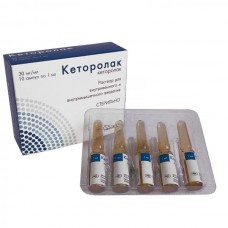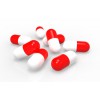Expiration date: 05/2026
The composition and form of issue:
Solution for intramuscular injection, 1 ml contains:
Ketorolac trometamol (Ketorolac tromethamine) 30 mg
excipients: disodium edetate dihydrate (Trilon B) ethanol (ethyl alcohol) (anhydrous) propylene glycol sodium chloride sodium hydroxide 1 M solution water for injection
1 ml in ampoules of amber or glass lighting. 5 ampoules in blister from PVC film. 1 or 2 contour packaging with scarifier ampoule and a leaflet in the cardboard box. When using vials with a dot or ring fracture scarifier can not be embedded.
Description pharmaceutical form:
Transparent liquid of light yellow color.
Characteristic:
NSAIDs.
Pharmacokinetics:
Absorption in the/m introduction full and fast. Cmax after the/m introduction 30 mg — 2, 4 ág/ml, 60 mg — 4, 5 µg/ml, Tmax from 15 to 73 min. Linking plasma protein — 99%.
The time to reach CSS parenteral 24 hours, the appointment 4 times a day (subtherapeutic above) is when the/m introduction 15 mg — 0, 9 ug/ml, 30 mg — 1, 9 µg/ml.
Vd — 0, 15-0, 3 l/kg in patients with renal insufficiency Vd of a drug can increase in 2 times, and Vd its R-enantiomer — on 20%.
Passes into breast milk. More than 50% of the administered dose is metabolized in the liver to form pharmacologically inactive metabolites. The main metabolites are the glucuronide, which is excreted by the kidneys, and R-hydroxyketones. Displays 91% news, 6% — through the intestines.
T1/2 in patients with normal renal function with an average of about 5 h. T1/2 is increased in elderly patients and shortened young. Liver function does not affect T1/2. In patients with impaired renal function with creatinine concentration in plasma 19-50 mg/l (168-442 µmol/l) T1/2 increases to 10 h, with more pronounced renal failure — more than 13 hours
Total Cl with the/m introduction 30 mg — 0, 02 l/h/kg (0, 019 l/h/kg in elderly patients), patients with renal insufficiency with creatinine concentration in plasma 19-50 mg/l in the/m introduction 30 mg — 0, 015 l/HR/kg. is Not displayed by hemodialysis.
Description of the pharmacological action:
Has a strong analgesic effect, also has anti-inflammatory and mild antipyretic action. The mechanism of action is nonselective inhibition of activity of COX-1 and COX-2, catalyzes the formation of PG from arachidonic acid, which play an important role in the pathogenesis of pain, inflammation and fever. Strength of the analgesic effect comparable to morphine, significantly superior to other NSAIDs. After the/m introduction beginning analgesic action occurs within 0, 5 h, the maximum effect is achieved in 1-2 hours
Indications:
Pain syndrome moderate and strong intensity:
- injuries
- toothache
- pain in the postpartum and postoperative period
- oncological disease
- myalgia, arthralgia, neuralgia, radiculitis
- sprains, strains
- rheumatic disease.
Intended for symptomatic therapy, reducing pain and inflammation at the point of use, on disease progression is not affected.
Contraindications:
- hypersensitivity
- full or partial combination of bronchial asthma, recurrent polyposis of the nose and paranasal sinuses and intolerance of acetylsalicylic acid or other NSAIDs (including history)
- urticaria, rhinitis, caused by taking NSAIDs (in anamnesis)
- intolerance drugs pirazolonovogo number
- hypovolemia (whatever the causes that caused it)
- erosivno-azwenne shock syndrome in acute phase
- hypocoagulation (including hemophilia)
- bleeding or high risk of their development
- severe renal insufficiency (Cl creatinine <30 ml/min.)
- severe hepatic impairment or active liver disease
- status after conducting coronary artery bypass surgery
- confirmed hyperkalemia
- pregnancy (III trimester)
- inflammatory bowel disease
- stage of labor
- lactation
- children up to age 16 years (safety and efficacy not established).
With caution:
- bronchial asthma
- the presence of factors that increase the toxicity against the gastrointestinal tract: alcohol, tobacco and cholecystitis
- postoperative period
- chronic heart failure
- edema syndrome
- arterial hypertension
- the impairment of renal function (plasma creatinine below 50 mg/l)
- cholestasis
- active hepatitis
- sepsis
- systemic lupus erythematosus
- concomitant use with other NSAIDs
- CHD
- cerebrovascular disease
- dyslipidemia/hyperlipidemia
- diabetes
- peripheral arterial disease
- Cl creatinine 30-60 ml/min
- ulcerative lesions of the gastrointestinal tract in the anamnesis
- the presence of Helicobacter pylori infection
- prolonged use of NSAIDs
- serious somatic diseases
- simultaneous administration of oral corticosteroids (including prednisone), anticoagulants (including warfarin), antiplatelet agents (including clopidogrel), SSRIs (including citalopram, fluoxetine, paroxetine, sertraline)
- elderly age (over 65 years)
- pregnancy (I and II trimester).
Side effect:
Often >3% less often 1-3% rare — <1%.
From the digestive system: often — gastralgia, diarrhea, less often — stomatitis, flatulence, constipation, vomiting, feeling of fullness of the stomach rarely — loss of appetite, nausea, erosive-ulcerative lesions of the gastrointestinal tract (including with perforation and/or bleeding — abdominal pain, spasm or burning sensation in the epigastric region, blood in the stool or melena, vomiting with blood or like "coffee grounds", nausea, heartburn, etc.), cholestatic jaundice, hepatitis, hepatomegaly, acute pancreatitis.
From the urinary system: rarely — acute renal failure, back pain, hematuria, azotemia, hemolyticuremic syndrome (hemolytic anemia, renal failure, thrombocytopenia, purpura), increased frequency of urination, increase or decrease the volume of urine, nephritis, edema of renal origin.
From the sensory organs: rarely — hearing loss, ringing in the ears, visual disturbances (including blurring of visual perception).
The respiratory system: rarely bronchospasm or dyspnoea, rhinitis, pulmonary edema, laryngeal edema (shortness of breath, difficulty breathing).
CNS: frequently — headache, dizziness, drowsiness, rarely — aseptic meningitis (fever, severe headache, convulsions, rigidity of the muscles of the neck and/or back), hyperactivity (change in mood, anxiety), hallucinations, depression, psychosis, fainting.
From the CCC: less often — increased blood pressure.
Organs of hematopoiesis: rarely — anemia, eosinophilia, leukopenia.
From the hemostatic system: rarely — bleeding from the postoperative wound, nasal bleeding, rectal bleeding.
With the skin: less often — skin rash (including maculopapular rash), purpura rare — exfoliative dermatitis (fever with or without chills, redness, induration, or scaling of the skin, the enlargement and/or tenderness of the tonsils), urticaria, malignant exudative erythema (Stevens-Johnson syndrome), toxic epidermal necrolysis (Lyell's syndrome).
Local reactions: less often — burning or pain at the injection site.
Allergic reactions: rare — anaphylaxis or anaphylactoid reaction (discoloration of the skin, skin rash, hives, itching of the skin, tachypnea or dyspnea, swelling of the eyelids, periorbital swelling, wheezing, shortness of breath, heaviness in chest, wheezing).
Other: often — swelling (face, legs, ankles, fingers, feet, increased body mass), less often — increased sweating rarely tongue swelling, fever.
Drug interaction:
Reception with other NSAIDs, GKS, ethanol, corticotropin, calcium supplementation increases the risk of ulceration of the mucous membrane of the gastrointestinal tract and the development of gastrointestinal bleeding.
Simultaneous administration with anticoagulant drugs (coumarin derivatives and indandiona, heparin with thrombolytic drugs — alteplase, streptokinase, urokinase), antiplatelet drugs, cephalosporins, valproic acid and acetylsalicylic acid increases the risk of bleeding.
Reduces the effect of antihypertensive and diuretic drugs (decreases synthesis of GHGs in the kidneys).
Appointment together with methotrexate increases hepato - and nephrotoxicity (joint appointment is possible only when you are using low doses of the latter and control its concentration in the plasma).
In the appointment with other nefrotoksicnami drugs (including drugs with gold) increased risk of nephrotoxicity.
Drugs that block tubular secretion, reduce the clearance of Ketorolac and increase its concentration in plasma.
Increases the effect of narcotic analgesics.
Myelotoxic HP increase symptoms gematotoksichnosti drug.
Method of application and doses:
In/m. for parenteral administration to patients 16 to 64 years with a body weight exceeding 50 kg/m for 1 introduction is administered not more than 60 mg usually 30 mg every 6 hours for Adult patients weighing less than 50 kg or with chronic renal failure 1 introduction administered not more than 30 mg is usually 15 mg (20 doses in 5 days). Maximum daily dose for patients 16 to 64 years with a body weight exceeding 50 kg and 90 mg/day for adult patients with body weight less than 50 kg or with renal insufficiency and elderly patients (over 65 years) — 60 mg. The duration of treatment should not exceed 5 days.
Overdose:
Symptoms (repeated introduction): abdominal pain, nausea, vomiting, erosive-ulcerative lesions of the gastrointestinal tract, impaired renal function, metabolic acidosis.
Treatment: symptomatic (maintaining vital body functions). Dialysis is ineffective.
Special instruction:
The appointment of a drug it is necessary to clarify the question about previous Allergy to the drug, or NSAID. Due to the risk of allergic reactions to the first dose administration is performed under the close supervision of a doctor.
Hypovolemia increases the risk of nephrotoxic adverse reactions. If necessary, you can assign in combination with narcotic analgesics. Not recommended for use as drugs for sedation, anesthesia maintenance.
When co-administered with other NSAIDs may experience fluid retention, decompensation of cardiac activity, increased blood pressure. Influence on platelet aggregation is terminated 24-48 hours. do Not use simultaneously with paracetamol more than 5 days.
Patients with impaired blood clotting prescribed only under constant control the number of platelets, especially important for postoperative patients, requiring careful control of hemostasis.
To reduce the risk of development of NSAID-gastropathy are assigned antacid drugs, misoprostol, omeprazole.
The risk of development of medical complications increases with the elongation of treatment (in patients with chronic pain) and increase the dose over 40 mg/day. During the period of treatment must be careful when driving and occupation of other potentially hazardous activities, require high concentration and psychomotor speed reactions. To reduce the risk of adverse effects from the blood should use the minimum effective dose minimum possible short course.




